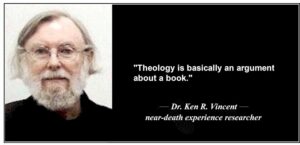This site uses affiliate links to Amazon.com Books for which IANDS can earn an affiliate commission if you click on those links and make purchases through them.
1. About Dr. Ken R. Vincent
Dr. Ken R. Vincent (died 2024) received his doctorate in Counseling Psychology from the University of Northern Colorado in 1973. He retired from teaching Psychology and the Psychology of Religious Experience at Houston Community College. He was a member of the Alister Hardy Society for the Study of Spiritual Experience and the International Association of Near-Death Studies (IANDS). Dr. Vincent served as a founding Board member of the Christian Universalist Association and was the former webmaster of The Universalist Herald website. His writings all contain a strong undercurrent of Universalist thought. In his book The Magi: From Zoroaster to the Three Wise Men, he compares the religion of the Magi (Zoroastrianism) to Christianity and shows the parallels of Universal Restoration in both faiths. In Visions of God from the Near-Death Experience, the wisdom of the prophets and sages of the world’s religions is superimposed upon the accounts of modern-day near-death experiencers to illustrate the similarities between them. Dr. Vincent‘s book The Golden Thread: God’s Promise of Universal Salvation documents the solid support for Universal Salvation in the Bible as well as research into NDEs and Mystical / Religious / Spiritual Experiences. This series of articles by Dr. Vincent are reprinted in his book entitled God Is With Us: What Near-Death and Other Spiritually Transformative Experiences Teach Us About God and Afterlife.
ABSTRACT: An after-death communication (ADC) is a spontaneous experience of communication with a deceased friend or family member. This study examines 1667 cases on the After-Death Communication Research Foundation website (ADCRF.org). A total of 336 (20.1%) were found to be evidential. The three main categories of evidential ADCs and previous research are discussed.
The following article is Ken R. Vincent’s paper about his ADC study as published in De Numine, No.70, Spring 2021, 4-6, reprinted with permission.
2. Study of Evidential After-Death Communications
By Dr. Ken R. Vincent
After-death communications have been reported throughout recorded history. If one includes religious visions, Jesus is the most famous example (1 Cor. 15:5-8). ADCs have been estimated to occur in 35-40% of the population (Streit-Horn, 2011, 60). ADCs occur in people of all ages, races, and religions. They are extremely comforting and helpful to the people who have them and helpful in the resolution of grief (Streit-Horn, 2011, p 73). Most ADCs are private experiences and do not provide evidence of an afterlife. The present study deals only with evidential cases.
The cases were drawn from the After-Death Communication Research Foundation website (ADCRF.org) which is owned by Jeff and Jody Long. Jody Long, webmaster, kindly gave me permission to do this study, and I am grateful for all her help in making this possible.
The ADCRF website asks experiencers to submit their account and answer a brief questionnaire. Cases submitted that are not in English are translated by volunteers. While some researchers (Vincent, 2019, 49-65) include divine beings and others include strangers (aka, ghosts) (Haraldsson, 2012, 145-152), the ADCRF website and this study use this definition: An after-death communication (ADC) is a spontaneous experience of communication with a deceased friend or family member. The use of mediums, psychomanteums, hypnosis, drugs, and other forms of necromancy are excluded.
Additionally, evidential cases selected are limited to visual, auditory, significant tactile contact, and sense of presence. “Signs” used by some researchers (Guggenheim & Guggenheim, 1995) such as smells, orbs, butterflies out of season, double-rainbows, clocks starting and stopping, lamps flickering, lights flashing are excluded. Finally, this study includes persons who are awake, asleep, or in-between, in contrast to those researchers who limit their studies to those who are awake (Stevenson, 1982, 349).
I will begin with a non-evidential case of my own. It was a wonderful experience and as real today as when I experienced it, but it offers no proof to anyone but me:
About two weeks after my father died, he appeared to me in a vivid dream and said, “Son, being dead takes some getting used to, but you’ll like it”. This vivid dream was comforting to me, although before the dream I had no doubt that my father was in a good place.
Of the 1667 cases examined, 336 (20.1%) were considered evidential. These cases fall into three commonly researched categories:
(1) Apparitions appearing prior to the experiencer’s knowledge of their death (APD) numbered 180 (10.8%) of the sample. Here is a very common example:
Case 29. Her aunt came to her in a dream and told her goodbye and that she had died. She “woke up screaming” and her phone was ringing. It was her sister telling her that her aunt had just died.
(2) Apparitions appearing to multiple witnesses (AMW) numbered 57 (3.4%) of the sample. Here is an example:
Case 630. A young woman and her fiancé had an early morning appearance of her dead grandfather. Though her grandfather did not speak both she and her fiancé heard, “call you mother and tell her I love her”. When she called her mom, her mother was highly emotional as he had just appeared to her also, but began calming down when she learned about her daughter and her fiancé’s experience.
(3) Apparitions that convey knowledge unknown to the experiencer that is later proven to be true (AKU) numbered 99 (5.9%) of the sample. Here are 2 examples:
Case 667. A man goes with his girlfriend to clear her dead father’s things. While there he felt a presence in the bathroom and there was a brightness in the room. When he left the bathroom: “I felt a hand on the back of my neck pushing my head down and my attention was instantly riveted to a small and what would normally be an unnoticeable drawer near the floor.” When he opened it he found a bank passbook with his girlfriend as the co-signatory!
Here is another of my own examples:
My grandfather died at the age of 90, the year I was born. My father, who was Executor of his estate, told me that on many occasions after his own father’s death, he had reoccurring dreams of his father telling him that there was an error on the inheritance. The property stayed in common, and we leased it out to my uncle Logan for ranching and oil companies for exploring until 1978. When we sold the ranch, the lawyer of the buyer found a minor error in the way my father had divided up the property —just as my grandfather had tried to communicate to my father.
Recently, Streit-Horn (2011, 27) reviewed 50,682 published ADC cases from 24 countries but did not examine evidential cases. In a study of evidential cases, Stevenson (1982, 349), using the 1894 Census of Hallucinations found 95 cases of apparitions appearing to multiple witnesses while awake. Bill and Judy Guggenheim’s 1995 book Hello From Heaven is based on 3300 first-hand ADCs collected by them. Of the 353 cases presented in their book, I identified 65 evidential cases. To date, the Guggenheims have not published a new book, but they continue to collect cases on their website (www.after-death.com).
In The Departed Among the Living, Erlendur Haraldsson used 449 cases from two studies: one study in 1975 used a random sample of 128 cases while the second study in 1980 used a self-selected sample of 321 cases. He found little difference between the two samples. Haraldsson had 41 cases of multiple witnesses in his sample but was able to locate only 29 to verify the incident.
Another large study to date is that of Evelyn Elsaesser, Chris A. Roe, Callum E. Cooper, and David Lorimer. Her team used an extensive questionnaire of 194 items that was available online in English, French, and Spanish. Of the 1004 completed questionaires, crisis ADCs accounted for 20.7%. (This is similar to my own study’s APD category.) Shared ADCs accounted for 20.9%, and experiencers receiving information previously unknown to them accounted for 24.3% of the cases.
The above-mentioned studies vary in the percentage of cases having evidential ADCs. Obviously, most of this can be explained by sampling techniques, subject’s questionnaires, and the definition of what the researchers consider evidential.
Nevertheless, these studies provide support for an afterlife. The often-touted “Super Psi” theory has lately been discredited by David Rousseau (2012) in his analysis of NDEs versus “Super Psi.” It stands to reason that the same case can be made for the related phenomena of ADCs.
Near-Death Experiences will always be the “show horse” of research into the afterlife, but After-Death Communications are the “workhorse” with many more evidential cases.
3. References
Elsaesser, E., Roe, C. A., Cooper, C. E., & Lorimer, D. (2020) Investigation of the Phenomenology and Impact of Spontaneous and Direct After-Death Communications (ADCs) [PDF] – Research Findings, https://www.evelyn-elsaesser.com/research/ , retrieved 12-10-2020.
Guggenheim, B. & J. (1995) Hello From Heaven, Bantam Books.
Haraldsson, E. (2012) The Departed Among the Living, White Crow Books.
Rousseau, D. (2012) The implications of near-death experiences for the research into survival of consciousness, Journal of Scientific Exploration, 26 (1), 43-80.
Stevenson, I. (1982) The contribution of apparitions to the evidence for survival [PDF]. Journal of the American Society for Psychical Research, 76 (Oct) 341-353.
Streit-Horn, J. (2011) A Systematic Review on After-Death Communication (ADC), Dissertation UNT https://digital.library.unt.edu/ark:/67531/metadc84284/ , retrieved 12-10-2020.
Vincent, K. R. (2019) God Is With Us, What Near-Death and Other Spiritually Transformative Experiences Teach Us About God and Afterlife. White Crow Books.
Originally published in De Numine, No.70, Spring 2021, 4-6, reprinted with permission.


















